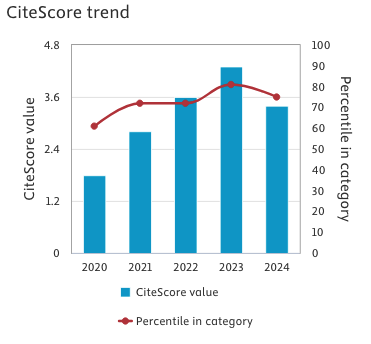Gamma-glutamyl transferase profile in various degrees of pruritus in cholestatic patients
Keywords:
biomarkers, pruritus, cholestasis, gamma-glutamyl transferaseAbstract
Introduction: Cholestasis, a condition affecting liver function, can lead to complications like pruritus, fatigue, osteoporosis, hyperlipidemia, and steatorrhea. Pruritus is a presenting symptom in chronic cholestasis, often seen in intrahepatic disorders. It can impair life quality and be difficult to diagnose. Gamma-glutamyl transferase (GGT), a biomarker used to detect cholestasis, is linked to pruritus by inhibiting glutamine synthesis and stimulating glutamyl transferase. This study aims to determine the profile of GGT in cholestatic individuals with varying levels of pruritus.
Methods: This cross-sectional observational study was conducted at RSUP Wahidin Sudirohusodo in Makassar and involved cholestatic patients diagnosed with chronic cholestasis. We collected demographic information, measured CGT levels in a lab prior to therapy, and used a 5D pruritus scale to measure pruritus. Data analysis was conducted using SPSS 26.
Results: The study involved 78 participants, with a mean age of 53.8 ± 14.6 years. GGT values ranged from 15-784, and pruritus scale scores varied from 5-25. A significant negative correlation was found between GGT levels and pruritus scale scores (r = -0.510; p < 0.001). The mean GGT level was significantly lower in very severe pruritus (104.3) and greatest in moderate pruritus (356.9).
Conclusion: This study concludes that greater levels of GGT correlate with reduced pruritus severity.
References
1. Cattley RC, Cullen JM. Liver and gall bladder. In: Wallig MA, Haschek WM, Rousseaux CG, Bolon B, Mahler BW, editors. Fundamentals of toxicologic pathology. 3rd ed. London: Academic Press; 2018. p. 125–51. doi: 10.1016/B978-0-12-809841-7.00008-3
2. Asensio M, Ortiz-Rivero S, Morente-Carrasco A, Marin JJG. Etiopathogenesis and pathophysiology of cholestasis. Explor Dig Dis. 2022:97–117. doi: 10.37349/edd.2022.00008
3. Chen H, Wu L, Hsin S, et al. Jaundice revisited: recent advances in the diagnosis and treatment of inherited cholestatic liver diseases. J Biomed Sci. 2018;25(1):75. doi: 10.1186/s12929-018-0475-8
4. Prelipcean CC, Mihai B, Diseases M. Extrahepatic complications of chronic cholestasis: current diagnosis and treatment. Rev Med Chir Soc Med Nat. 2012;116(2):490–9. PMID: 23077943
5. Pedersen MR, Mayo MJ. Managing the symptoms and complications of cholestasis. Clin Liver Dis. 2020;15(3):120–4. doi: 10.1002/cld.901
6. Azevedo RA, Takamatsu FY, Kondo M, et al. Pruritus in cholestasis. Rev Soc Bras Clin Med. 2017;55(11):61–7
7. De Vloo C, Nevens F. Cholestatic pruritus: an update. Acta Gastroenterol Belg. 2019;82(1):75–82. PMID: 30888758
8. Bhalerao A, Mannu GS. Management of pruritus in chronic liver disease. Dermatol Res Pract. 2015;2015:295891. doi: 10.1155/2015/295891
9. Nietsche TR, Dotta G, Barcaui CB, Ferraz MLCG. Cholestatic pruritus: a knowledge update. An Bras Dermatol. 2022;97(3):332–7. doi: 10.1016/j.abd.2021.06.007
10. Bunchorntavakul C, Reddy KR. Pruritus in chronic cholestatic liver disease. Clin Liver Dis. 2012;16(2):331–46. doi: 10.1016/j.cld.2012.03.010
11. Haijer FW, Van Vliet CB, Brusse-Keizer MGJ, Van Der Palen JAM, Kerbert-Dreteler MJ, Kolkman JJ. Gamma-glutamyl transferase: a friend against cholestatic itch? A retrospective observational data analysis in patients with extrahepatic cholestasis. Int J Hepatol. 2023;2023:5–8. doi: 10.1155/2023/2903171
12. Rodrigo M, Dong X, Chien D, Karnsakul W. Cholestatic pruritus in children: conventional therapies and beyond. Biology (Basel). 2023;12(5):1–12. doi: 10.3390/biology12050756
13. Krishnamurthy HA. The serum gamma glutamyl transpeptidase: a non invasive diagnostic biomarker of chronic anicteric non alcoholic liver diseases. J Clin Diagn Res. 2013;7(4):691–4. doi: 10.7860/JCDR/2013/5569.2883
14. Ebata T, Ishiuji Y, Saeki H, Nakagawa H. Creation of a Japanese version of the 5D itch scale. Jpn J Dermatol. 2015;125:1035–40
15. Kee JL. Pearson handbook of laboratory & diagnostic tests: with nursing implications. 7th ed. Upper Saddle River (NJ): Pearson; 2013
16. Beuers U, Kremer AE, Bolier R, Elferink RPJO. Pruritus in cholestasis: facts and fiction. Hepatology. 2014;60(1):399–407. doi: 10.1002/hep.26909
17. Patel SP, Vasavda C, Ho B, Meixiong J, Dong X, Kwatra SG. Cholestatic pruritus: emerging mechanisms and therapeutics. J Am Acad Dermatol. 2019;81(6):1371–8. doi: 10.1016/j.jaad.2019.04.035
Downloads
Published
Issue
Section
License
Copyright (c) 2025 Baharuddin Wahyu Usman, Nu'man As Daud, Tutik Harjianti, Syakib Bakri, Andi Makbul Aman, Arifin Seweng

This work is licensed under a Creative Commons Attribution-NonCommercial 4.0 International License.
This is an Open Access article distributed under the terms of the Creative Commons Attribution License (https://creativecommons.org/licenses/by-nc/4.0) which permits unrestricted use, distribution, and reproduction in any medium, provided the original work is properly cited.
Transfer of Copyright and Permission to Reproduce Parts of Published Papers.
Authors retain the copyright for their published work. No formal permission will be required to reproduce parts (tables or illustrations) of published papers, provided the source is quoted appropriately and reproduction has no commercial intent. Reproductions with commercial intent will require written permission and payment of royalties.






